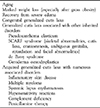INTRODUCTION
Body deformities after bariatric surgery and radical weight loss have recently grown in frequency. This body deformity was called to attention in order to address skin redundancy, excess skin or contour deformity after weight loss, but no appropriate term described these conditions. Kreidstein1first proposed the term "Cutis pleonasmus," which is Greek for "skin redundancy." This referred to the excess skin and tissue that remained after massive weight loss and was suggested as a valid disease entity that requires at least 2 of the following criteria: an identified etiologic factor, a recognizable group of signs and symptoms and persistent anatomical changes. Although cutis pleonasmus is treated mostly by the Department of Plastic Surgery, dermatologists should be aware of this entity as it needs to be distinguished from rare connective tissue diseases that manifest with generalized skin laxity. Also, other specialty departments, including bariatric surgery and obesity control clinics, should be familiar with this entity in order to diagnose, treat and prevent its occurrence and to educate patients.
CASE REPORT
A 24-year-old man presented with generalized lax and loose skin on the trunk and extremities for 2 months. He had a history of massive weight reduction from 160 kg to 90 kg over a 6-month period. Cutaneous manifestations revealed excessive rolls of skin and tissue on the trunk and proximal extremities, which resembled "batwing" skin along the upper arms and thighs. There were extra skin folds along the lateral chest, a sagging abdomen, mons pubis ptosis and drooping breasts and buttocks (Fig. 1). Ophthalmologic and other physical examination showed no abnormal findings. Laboratory evaluations, including complete blood cell count, liver/renal function tests, urinalysis and VDRL, were within normal ranges. The resting electrocardiogram showed normal sinus rhythm without significant abnormalities and blood pressure was 114/66 mmHg. Histological specimens from the right lateral chest wall and neck were normal (Fig. 2A) without abnormal fragmentation or loss of elastic fibers by Verhoeff van Gieson stain (Fig. 2B). He was diagnosed with cutis pleonasmus based on the characteristic clinical features subsequent to massive weight loss and the normal histological findings. He was referred to the Department of Plastic Surgery for body contour surgery, but he refused the surgery.
DISCUSSION
Cutis pleonasmus usually develops after massive weight loss (at least 80~300 lb)2. Body shape will be more significantly affected by a greater difference between body mass index (BMI) before and after weight loss2. Cutaneous manifestations are comprised of skin redundancy and folds, which commonly affect the arms, thighs, buttocks and abdomen3. Depending on the pattern of weight loss, various clinical presentations are observed, including excessive skin folds on the back, flanks and hips, a sagging abdomen, rolls of skin along the lateral chest and drooping breasts and buttocks2. Also, mons pubis ptosis and batwing-like skin along the upper arms can be found2. A diagnosis of cutis pleonasmus is based on a history of massive weight reduction and the characteristic clinical features mentioned above.
Medical problems, such as intertrigo or functional limitations in walking, urinating and sexual activity, may accompany cutis pleonasmus34. The excess skin redundancy may cause recurrent infections, tissue necrosis and ulceration56. Additionally, patients with cutis pleonasmus have serious cosmetic and psychological problems.
Cutis pleonasmus must be clearly distinguished from other conditions presenting with increased laxity of the skin, such as aging, pseudoxanthoma elasticum, congenital and acquired cutis laxa (Table 1)7. Congenital cutis laxa is a rare inherited disease that is characterized by inelastic, loose, pendulous skin, which gives the appearance of premature aging8. The cutaneous changes may be present at birth or may occur during infancy with severe pulmonary and cardiovascular involvements9. In addition, histopathological features of congenital cutis laxa show a loss or fragmentation of elastic fibers, in contrast to normal histological findings in cutis pleonasmus.
Pseudoxanthoma elasticum differs from cutis pleonasmus by the clinical findings of yellowish skin papules in a cobblestone pattern and redundant folds in flexural sites, and histopathological features characterized by clumped and distorted elastic fibers with calcium deposition10. Moreover, pseudoxanthoma elasticum is a hereditary disorder with extracutaneous manifestation of angioid streaks, claudification, hypertension and angina11. Although de Barsey syndrome, SCARF syndrome and geroderma osteodysplastica may present generalized cutis laxa, they are usually accompanied by retarded psychomotor development, ocular and skeletal abnormalities121314.
To prevent body contour deformity, proper weight loss is recommended. The initial goal of weight loss should be to reduce body weight by 10 percent from baseline over a 6-month period15. The treatment for cutis pleonasmus is contour surgery. Several therapeutic modalities, such as brachioplasty, reduction mammaplasty, mastopexy, abdominoplasy, upper body lift and buttock lipectomy, have been introduced16. To determine the appropriate surgical intervention, a variety of classification systems have been suggested and several different surgical procedures may be used for one patient16171819.
In summary, we presented a case of cutis pleonasmus, which has not been previously reported in Korea. Because massively obese patients are relatively uncommon and bariatric surgery is not popular, the prevalence of cutis pleonasmus may be rare in Korea. However, changes to Western lifestyles may lead to significant weight gains, thus leading to increased occurrences of cutis pleonasmus. The dermatologist, bariatric surgeon and obesity control clinician, as well as the plastic surgeon, should be aware of this disease entity for correct diagnosis, management and prevention.




 PDF
PDF ePub
ePub Citation
Citation Print
Print





 XML Download
XML Download